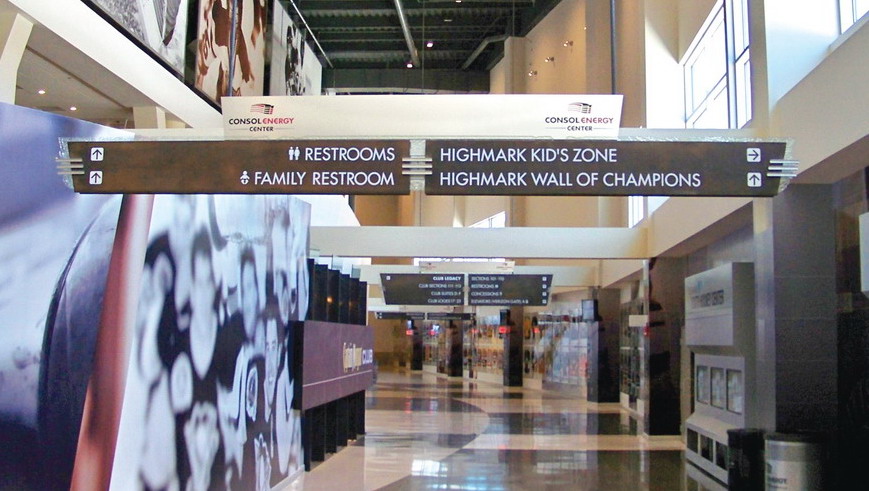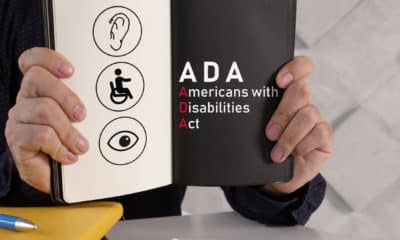The days of fans for NHL teams cheering on their teams in dank, rusty arenas will soon evaporate. Like devotees of other professional teams, they expect inviting, new-generation facilities, such as Columbus, OH’s Nationwide Arena and Minneapolis’ Xcel Energy Center.
The Pittsburgh Penguins’ ownership decisively threw their hat in the ring among top-shelf NHL stadia by constructing the Consol Energy Center, the “Pens’” $321-million, 18,087-seat facility that opened for the 2010-2011 NHL season. According to www.bleacherreport.com, it offers one concession stand for every 158 people (goodbye, long lines). Populous Architects (Kansas City), a preeminent architect of sports stadia worldwide, built Pittsburgh’s new hockey temple. Architectural amenities include glass windows along one entire side of the arena and an encircling plaza of trees.
To help Consol convey powerful environmental-graphic design (EGD), Populous enlisted Pittsburgh-based Kerestes Martin Associates Inc. (KMA Design), an EGD provider, to develop the program, and L & H Sign Co. (Reading, PA) to coordinate fabrication.
Barbara J. Martin, KMA’s CEO, said the firm accepted the dual role of ensuring consistent directional messaging throughout the facility and referencing the architecture and Pittsburgh’s industrial legacy and vernacular through the signs’ color and material palette.
“Signage scale and placement is extremely important because wayfinding must be accessible, as it contains vital facility information,” she said. “Visitors are predisposed to looking at the same location as they’re pulled through a facility.”
To cultivate a Steel City sense of place and a hockey rink’s icy surface, KMA specified cold-rolled, brake-formed, blackened-steel for the signs’ main panels, with textured acrylic that replicates crackled ice on the panels’ periphery, and brushed-aluminum accents.
Advertisement
Chris Heinly, L & H’s president, addressed the $1.1 million wayfinding project: “It was challenging to engineer solutions that highlighted the system’s creative design within a confined space, such as an arena.”
After L & H developed the project template using SolidWorks® 3-D software, it fabricated the steel with a laser cutter and the Flexibend RAS system. It delegated the steel-blackening process to Technique Architectural Products Inc. (Wilkinsburg, PA). Heinly said the blackening process required 12 different chemical techniques to create the desired effect. After having cleaned the steel with alcohol and naptha, L & H carefully applied white Avery vinyl with a heat gun and created the letters, and then reapplied carnauba wax methodically to avoid spreading rust onto the vinyl letters.
Fabrication of the acrylic panels was outsourced to Envel Design (Newbury Park, CA), which cast the acrylic in a “splatter web” pattern using its proprietary process. Shawn Mayer, Envel’s sales VP, said signs don’t currently represent a large segment of the company’s business, but noted it’s a growing market.
To support the suspended signs, L & H installed stainless-steel airplane cable. The shop also fabricated Consol’s ADA program using Gravo-Tac’s embedded-bead Braille system.



 Tip Sheet2 weeks ago
Tip Sheet2 weeks ago
 Photo Gallery4 days ago
Photo Gallery4 days ago
 Ask Signs of the Times6 days ago
Ask Signs of the Times6 days ago
 Real Deal2 weeks ago
Real Deal2 weeks ago
 Paula Fargo1 day ago
Paula Fargo1 day ago
 Benchmarks1 week ago
Benchmarks1 week ago
 Photo Gallery1 day ago
Photo Gallery1 day ago
 Women in Signs2 weeks ago
Women in Signs2 weeks ago







